This article was co-authored by Laura Marusinec, MD. Dr. Marusinec is a board certified Pediatrician at the Children's Hospital of Wisconsin, where she is on the Clinical Practice Council. She received her M.D. from the Medical College of Wisconsin School of Medicine in 1995 and completed her residency at the Medical College of Wisconsin in Pediatrics in 1998. She is a member of the American Medical Writers Association and the Society for Pediatric Urgent Care.
There are 21 references cited in this article, which can be found at the bottom of the page.
wikiHow marks an article as reader-approved once it receives enough positive feedback. This article received 27 testimonials and 93% of readers who voted found it helpful, earning it our reader-approved status.
This article has been viewed 515,743 times.
A broken wrist actually can include the distal radius and/or ulna as well as several other bones in the wrist (the carpal bones). It is a fairly common injury.[1] In fact, the radius is the most commonly broken bone in the arm. One in 10 broken bones in the United States is a broken distal radius.[2] A broken wrist can happen when you fall or get hit by something. People at particularly high risk for broken wrists include athletes who play high-impact sports and people with osteoporosis (thin, fragile bones). If you’ve been treated for a broken wrist, you will probably have to wear a splint or cast until your wrist heals. Read on to learn some ways to cope with a broken wrist.
Steps
Seeking Treatment
-
1Go to the doctor. A broken wrist requires medical attention so it can heal properly. If you aren’t experiencing a lot of pain, you can wait until you’re able to see your regular physician.[3] If you have any of the following symptoms, you should seek emergency medical attention:[4]
- Significant pain or swelling
- Numbness in the wrist, hand, or fingers
- A deformed appearance of the wrist, looking crooked or bent
- An open fracture (where the broken bone has pierced through the skin)
- Pale fingers
-
2Understand the treatment procedures. Most broken wrists are treated first with a splint, which is a rigid piece of plastic, fiberglass or metal attached to the wrist with bandages or a brace.[5] This is usually used for a week, until the swelling reduces.[6]Advertisement
-
3Wait 6 to 8 weeks. Most broken wrists heal within 6-8 weeks with proper treatment. This means you will probably have a cast for most of that time.[10]
- Your doctor will usually conduct regular x-rays through this period to make sure your wrist is healing correctly.
-
4See a physical therapist. After your cast comes off, you may be referred to a physical therapist. Physical therapy can help you regain the strength and motion that you lost after your injury.[11]
- If you don’t need formal physical therapy, your doctor will probably give you exercises to do at home. Make sure you follow your doctor’s recommendations to help your wrist return to its full functioning.
Easing Pain and Swelling
-
1Elevate the wrist. Elevating your wrist above the level of your heart will help reduce swelling and pain. It’s important to elevate your wrist for at least the first 48-72 hours after having a cast put on. Your doctor may recommend that you elevate it longer.
- You may also need to keep the wrist elevated while you sleep or during the day. Try propping it up on a few pillows.
-
2Apply ice to your wrist. Icing your wrist can help reduce swelling and ease your pain. Make sure to keep your cast dry while applying ice.
- Put ice in a zip-top plastic bag. Make sure the bag is sealed properly to avoid leaks. Wrap the bag in a towel to make sure condensation doesn’t get into your cast.
- You can also use a bag of frozen vegetables as an ice pack. Look for veggies that are small and even in size, such as corn or peas. (And obviously, don’t eat them after you’ve used the bag as an ice-pack.)[12]
- Hold the ice on your wrist for 15-20 minutes every 2-3 hours. Apply ice for the first 2-3 days, or as long as your doctor recommends.[13]
- You may also find it helpful to use a commercial gel-based ice pack. These are reusable, freezable ice packs that won’t melt and leak water onto a cast. You can find them at medical supply stores and most pharmacies.
-
3Take an over-the-counter painkiller. Most wrist pain can be treated with a non-prescription pain reliever.[14] You should talk with your doctor about what type of painkiller is appropriate for you. Some can interfere with medical conditions or other medications you’re taking. Your doctor may recommend a combination of ibuprofen and acetaminophen/paracetamol to fight pain and reduce swelling. These are more effective together than either one is alone.[15]
- Ibuprofen is an NSAID (non-steroidal anti-inflammatory drug). These help reduce fever and swelling by inhibiting your body’s production of prostaglandins. Other NSAIDs include naproxen sodium and aspirin, although aspirin has a more prolonged anti-clotting effect than other NSAIDs.
- Your doctor may not recommend aspirin if you have a bleeding disorder, asthma, anemia, or other medical condition. Aspirin can cause negative interactions with several medical conditions and medications.[16]
- When administering pain relievers to a child, be sure to use a children’s formula and follow the dosage for the child’s age and weight.[17] Aspirin is not recommended for children under age 18.
- There is a risk of liver damage when taking acetaminophen, so use only as much as recommended by your doctor.[18]
- Do not take an OTC painkiller for more than 10 days (5 days in children) unless directed by your doctor. If your pain persists after 10 days, see your doctor.
-
4Wiggle your fingers and move your elbow around. It’s important to exercise any joints that aren’t under the cast, such as your elbow and fingers, to keep circulation flowing.[19] This will help speed your healing process and increase mobility.
- If you experience pain when moving your elbow or fingers, contact your doctor.
-
5Avoid sticking objects into the cast. You may find that your skin gets itchy under the cast, and you’ll probably want to scratch it. Don’t! This can cause harm to your skin or the cast. Don’t poke or stick anything into the cast.
- Try raising your cast or blowing on it with a hairdryer on the “low” or “cool” setting instead.
- Don’t put powders into the cast, either. Anti-itch powders can cause irritation when they’re trapped under the cast.[20]
-
6Apply moleskin to prevent rubbing. Your cast may rub or irritate your skin where its edges meet your skin. You can apply moleskin, which is a soft fabric with an adhesive backing, directly to the skin where the cast is rubbing. You can purchase moleskin at drug stores and pharmacies.
- Apply moleskin to clean, dry skin. Replace it when it gets dirty or loses its stickiness.
- If the edges of your cast become rough, you can use a nail file to smooth out the rough edges. Don’t peel, cut, or break off pieces of your cast.
-
7Know when to call your doctor. In most cases, your wrist will heal in a few weeks with proper care. You should call your doctor if you experience any of the following:
- Numbness or tingling in your hand or fingers
- Cold, pale or blue fingers
- Increased pain or swelling of the area after the cast has been put on
- Raw or irritated skin around the edges of the cast
- Cracks or soft spots in the cast
- Wet, loose, or tight casts
- Casts that smell bad or itching that won’t go away
Managing Daily Tasks
-
1Avoid getting your cast wet. Because many casts are made of plaster, they are easily damaged by water. Getting the cast wet can also encourage mold or mildew growth inside the cast. Wet casts may also cause sores to form on your skin under the cast. Do not get the cast wet.
- Tape a heavy-duty plastic bag (such as a garbage bag) over your cast when you bathe or shower. Hold your cast outside the shower or bathtub so you reduce the likelihood of getting it wet.
- Wrap a washcloth or small towel around the top of your cast to keep water from leaking in under the cast.
- You may be able to purchase water-resistant cast shields from your doctor’s office or a medical supply store.
-
2Dry your cast immediately if it gets wet. If your cast does get wet, pat it dry with a bath towel. Then, use a hair dryer on the “low” or “cool” setting for 15-30 minutes.
- If the cast is still wet or soft after you’ve tried to dry it, call your doctor. You may need a new cast.
-
3Wear a sock on your hand. If your fingers get cold while you’re in your cast, you may be having circulation problems. (Or it could just be cold in your house.) Elevate your wrist and wear a sock on your hand to keep your fingers cozy.
- Wiggling your fingers can help restore circulation.
-
4Wear clothes that are easy to put on. Putting on clothes with fasteners such as buttons or zippers may be difficult while you’re in a cast. Wearing fitted clothing or clothes with tight sleeves isn’t usually a good idea, as these may not fit over a cast.
- Choose loose, stretchy clothing. Elastic-waisted pants or skirts mean you don’t have to fumble with fasteners.
- Shirts with short sleeves or sleeveless shirts are a good idea.
- Use your good arm to put the shirt sleeve over the cast and pull gently. Try to minimize how much you use the arm in the cast.
- Use a shawl or blanket to stay warm instead of a jacket, which could be harder to get into. A thick poncho or cape can be an easier choice rather than an outdoor coat.
- Don’t be embarrassed to ask for help when you need it.
-
5Ask for a note-taker in class. If you’re a student and you’ve broken the wrist of your dominant hand, you may need to ask for a note-taker or other accommodations while your wrist heals. Speak with your teacher or your university’s disability resources center.
- If you can learn to write with your non-dominant hand, this will help, but this can be difficult and takes a long time.
- If you’ve broken the wrist of your non-dominant hand, use a heavy object like a book or paperweight to hold paper in place while you’re writing. Use your injured arm as little as possible.
-
6Do tasks with your other hand. When you can, use your non-injured arm to do daily tasks such as brushing your teeth and eating. This will help reduce inflammation in your injured wrist.
- Don’t lift or carry things with your injured wrist. This could cause re-injury and prolong the healing process.
-
7Avoid driving or operating machinery. This is particularly important if you have broken the wrist of your dominant hand. It is unsafe to drive in a cast and your doctor will likely tell you not to drive.[21] [22]
- Although it is not illegal to drive with a wrist cast, use sound judgement when deciding whether to drive or not.
- Other machinery – particularly machinery that requires two hands to operate – should be avoided.
Healing after a Break
-
1Take care of your arm and wrist after the cast is removed. You will notice dryness and perhaps some swelling after the cast is removed.
- Your skin may also look dry or flaky. Your muscles may look smaller than when you put the cast on, which is normal.[23]
- Soak your arm/wrist in warm water for 5-10 minutes. Gently dry the skin with a towel.[24]
- Use a moisturizing cream on the wrist and arm to soften the skin.
- To reduce swelling, take ibuprofen or aspirin as recommended by your doctor.
-
2Take up normal activities as recommended by your doctor or physical therapist. It can take some time before you’re able to return to your full routine. In particular, you may need to wait 1-2 months to resume light exercise, such as swimming or cardio. Vigorous activities such as sports may require waiting 3-6 months.[25]
- Take care to prevent further injuries to your wrist. Braces can help prevent future wrist injuries.
-
3Remember that healing takes time. Just because your cast is off does not mean you are completely healed. It may take six months or longer to heal if the break was severe.[26]
- You may continue to have aches or stiffness for months or years after the initial break.[27]
- Your healing process is also affected by your age and overall health. Children and teens tend to heal faster than adults. Older adults and people with osteoporosis or osteoarthritis may not experience healing as fast or as fully.[28]
Warnings
- Seek medical attention for a broken wrist. Not receiving proper treatment can cause serious side effects.⧼thumbs_response⧽
References
- ↑ http://orthoinfo.aaos.org/topic.cfm?topic=a00412
- ↑ http://www.webmd.com/a-to-z-guides/colles-fracture
- ↑ http://orthoinfo.aaos.org/topic.cfm?topic=a00412
- ↑ http://www.webmd.com/a-to-z-guides/colles-fracture
- ↑ http://www.aafp.org/afp/2009/0901/p491.html
- ↑ http://www.webmd.com/a-to-z-guides/colles-fracture
- ↑ http://orthoinfo.aaos.org/topic.cfm?topic=a00412
- ↑ http://www.webmd.com/a-to-z-guides/colles-fracture
- ↑ http://orthoinfo.aaos.org/topic.cfm?topic=a00412
- ↑ http://www.webmd.com/a-to-z-guides/colles-fracture
- ↑ http://orthoinfo.aaos.org/topic.cfm?topic=a00412
- ↑ http://www.nhs.uk/conditions/broken-arm/Pages/Introduction.aspx
- ↑ http://www.webmd.com/a-to-z-guides/colles-fracture?page=2
- ↑ http://www.webmd.com/a-to-z-guides/colles-fracture?page=2
- ↑ http://orthoinfo.aaos.org/topic.cfm?topic=a00412
- ↑ https://www.drugs.com/aspirin.html
- ↑ http://www.webmd.com/drugs/2/drug-3852/non-aspirin-pain-relief-oral/details
- ↑ http://www.webmd.com/drugs/2/drug-3852/non-aspirin-pain-relief-oral/details
- ↑ http://www.nhs.uk/chq/Pages/2543.aspx?CategoryID=72&SubCategoryID=721
- ↑ http://www.nhs.uk/chq/Pages/2543.aspx?CategoryID=72&SubCategoryID=721
- ↑ http://well.blogs.nytimes.com/2013/12/03/when-is-it-safe-to-drive-after-breaking-a-bone/?_r=0
- ↑ http://newsroom.aaos.org/media-resources/Press-releases/is-it-safe-to-drive-with-my-arm-in-a-cast-frequently-asked-questions.tekprint
- ↑ http://kidshealth.org/teen/safety/first_aid/casts.html#
- ↑ http://www.ouh.nhs.uk/patient-guide/leaflets/files%5C121210wrist.pdf
- ↑ http://orthoinfo.aaos.org/topic.cfm?topic=a00412
- ↑ http://www.webmd.com/a-to-z-guides/colles-fracture?page=2
- ↑ http://orthoinfo.aaos.org/topic.cfm?topic=a00412
- ↑ http://orthoinfo.aaos.org/topic.cfm?topic=a00412
- ↑ http://www.nhs.uk/chq/Pages/2373.aspx
About This Article
If you have symptoms of a broken wrist, such as pain, swelling, numbness, or an obvious deformity in your wrist or hand, go to the doctor immediately. They’ll probably give you a splint or cast to wear for several weeks while your fracture heals. Once you get the cast removed, work with a physical therapist to do wrist-strengthening exercises. During the healing process, you can reduce pain and swelling by keeping your wrist elevated and applying ice packs for 15 to 20 minutes at a time. You can also use painkillers if your doctor says it’s okay. Read on for more tips from our Medical co-author, including how to do everyday tasks while your wrist is healing!

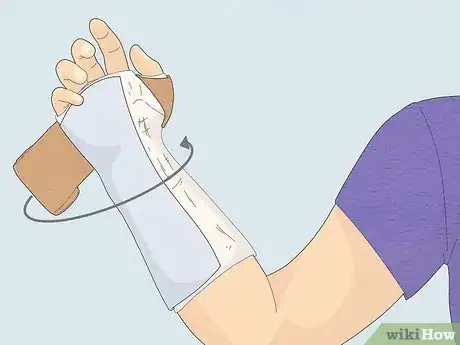

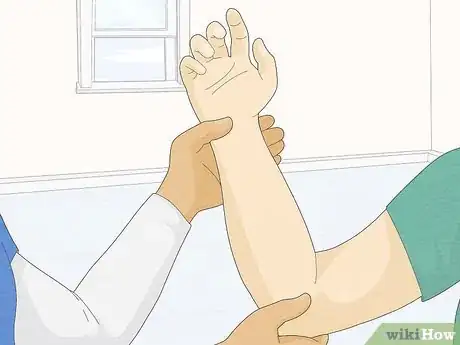
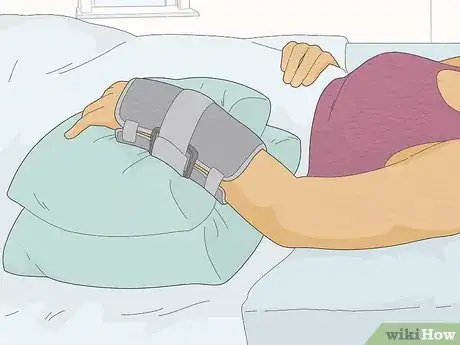
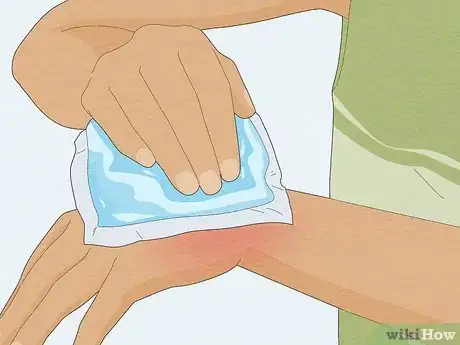
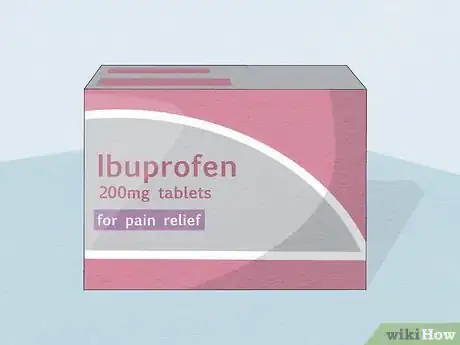
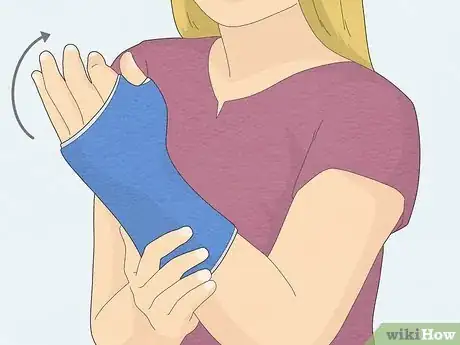
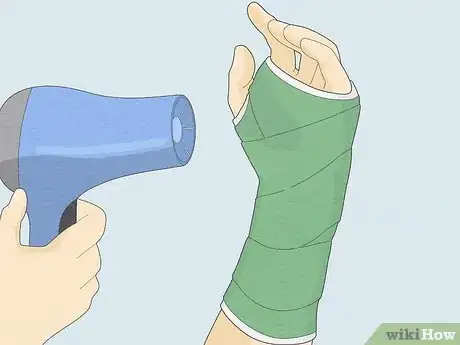
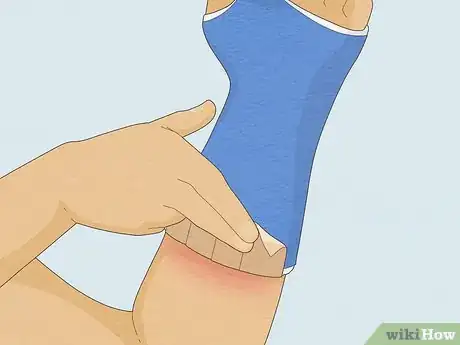

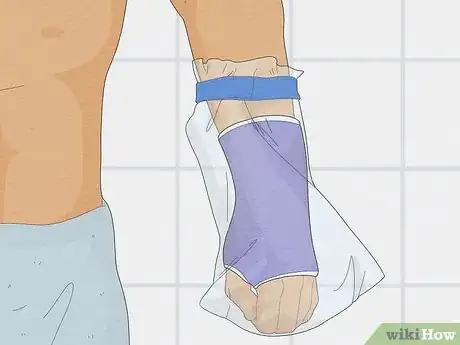
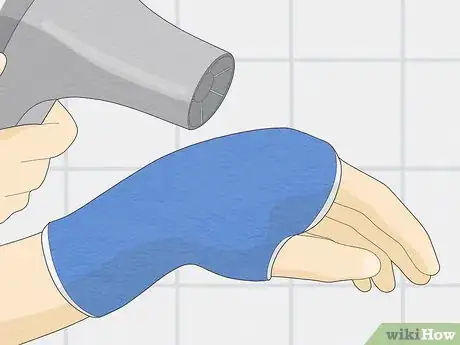

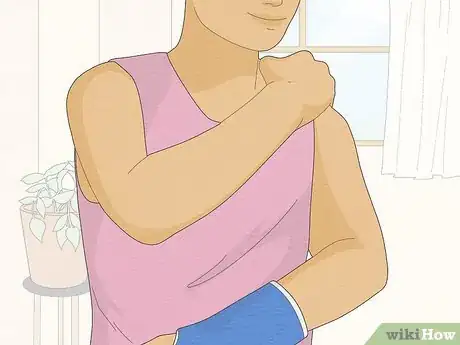
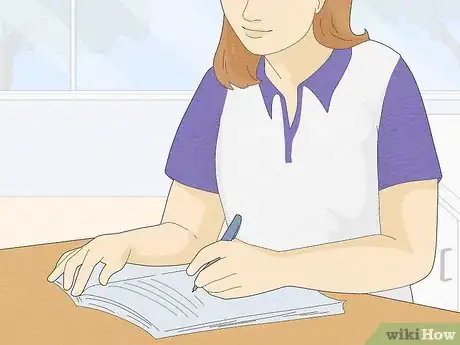
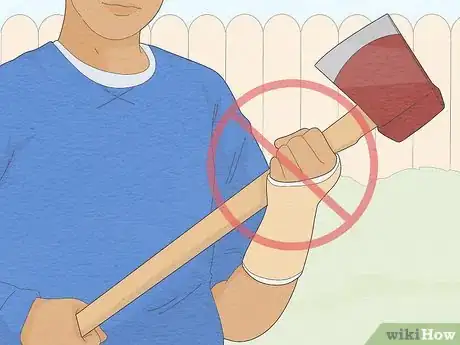



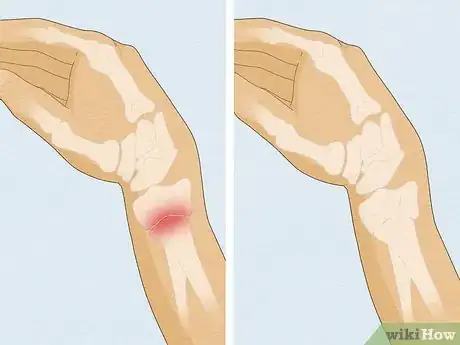
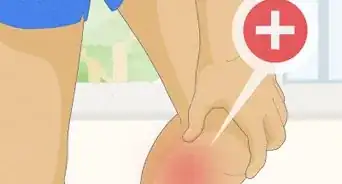
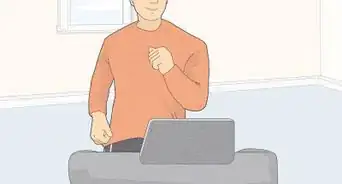



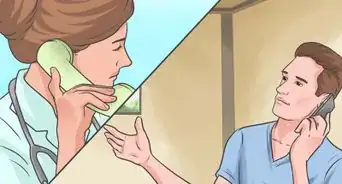
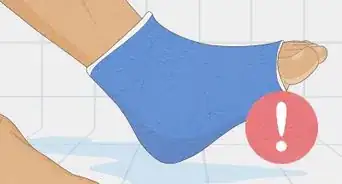

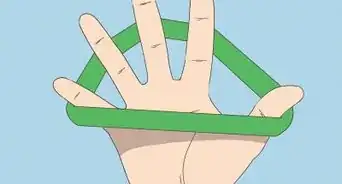

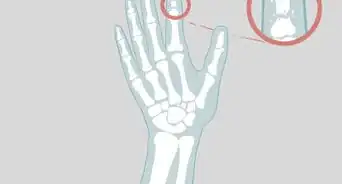













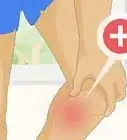





































Medical Disclaimer
The content of this article is not intended to be a substitute for professional medical advice, examination, diagnosis, or treatment. You should always contact your doctor or other qualified healthcare professional before starting, changing, or stopping any kind of health treatment.
Read More...